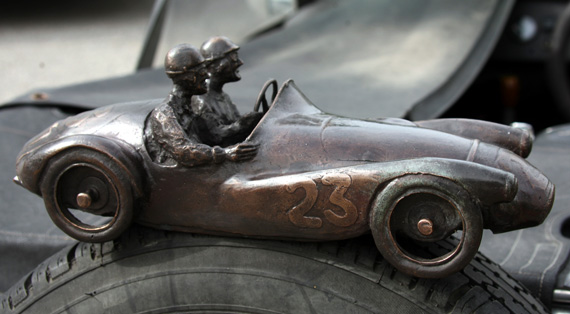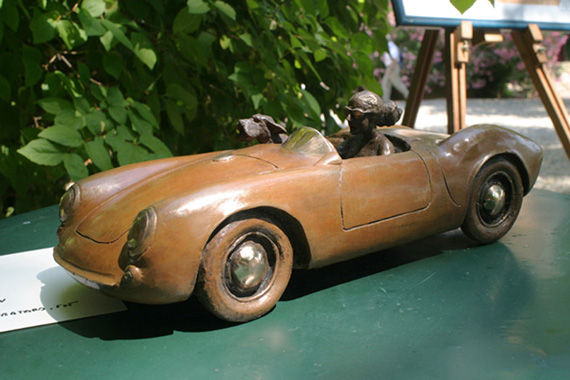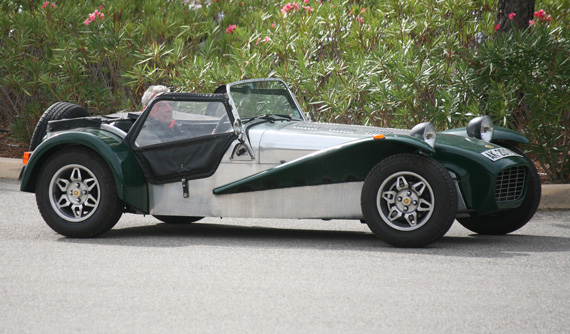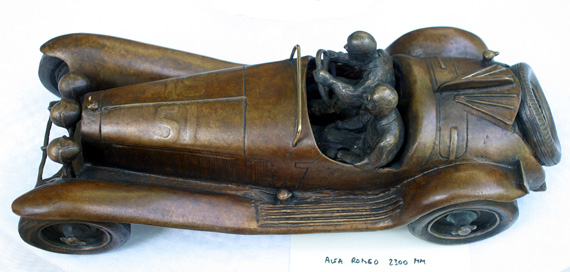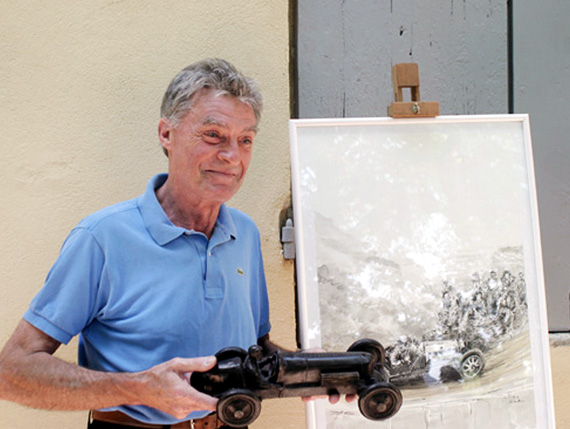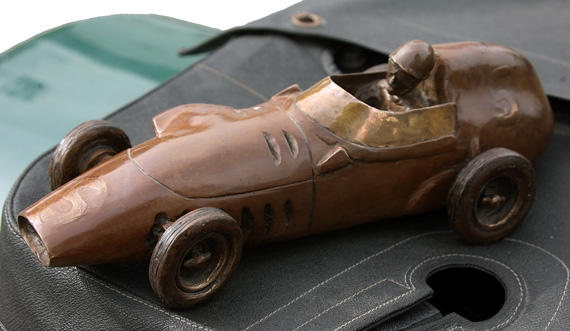Story and photos by Graham Gauld
If you should ever be in Monte Carlo, keep a look-out for an almost life-sized bronze statue to “Williams”, or William Grover-Williams to give him his correct name, the winner of the first Monaco Grand Prix in 1929. It is an expressive, rough-hewn work that usually stands right in the middle of St. Devote, the first corner of the Grand Prix circuit. Naturally, the statue is craned out of the way for the race but it is then craned back again after the grand prix as a permanent reminder of the first winner. The man who crafted this superb piece of work never had a single art lesson in his life but admits that he enjoyed drawing cars when he was young. He is Francois Chevalier, a 60 year-old ex-racing driver and former manager of the Paul Ricard circuit in the South of France.
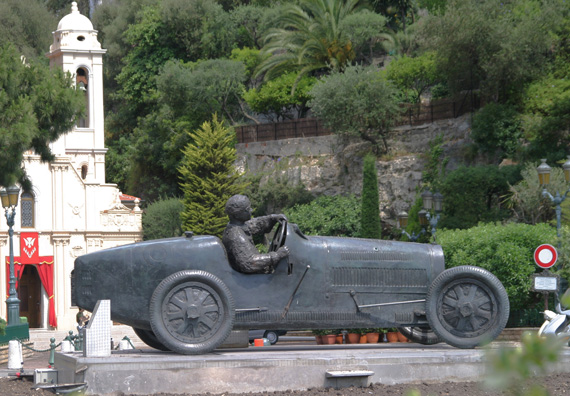
Somewhat ironic that the iconic statue of Williams in the Bugatti by Francois Chevalier is removed from St. Devote during the race!
Francois is a highly amusing man whose craggy face beams from under a shock of salt and pepper colored hair and has an uncomplicated view of the world. Eight years ago, the legendary Formula 1 guru Bernie Ecclestone bought the Paul Ricard circuit, and Francois lost the job he had held successfully for the previous thirty years. “One day one of Bernie’s henchmen arrived and asked for the keys and I was out of a job.”
It was probably the best thing that could have happened. It allowed Francois to go back to his house in the nearby village of Le Castellet and concentrate on his superbly evocative drawings and his sculptures, which have probably made him better known than he ever was as the manager at Paul Ricard.
His enduring attribute is an almost English sense of humor and it spreads into his work. For example at a recent exhibition, held in the bucolic setting of the Chateau de la Lieure, one of the pieces on show was a beautifully executed Porsche 550 Spyder complete with driver; but sitting on the passenger seat is a big floppy dog with ears stretched out behind in the slipstream. On the descriptive card beside the sculpture Chevalier had written “…the dog is a bastard and can be removed.”
True enough, the dog is just sitting loose in the Porsche and a purist can pluck it out and set it aside! Nearby was one of his pen and wash drawings of an enthusiast sitting on the toilet with an array of exhaust pipes hanging on the wall. The hand-inscribed caption on the painting says “ne pas jeter d’echappement dans le toilet.” (Don’t throw the exhaust pipe down the toilet.)
Today Francois Chevalier is in great demand for his pen and wash drawings that are used for historic race posters, invitations and all sorts of things to do with motoring and motorsport. He arrives at his shows with sheaves of his finished, half-finished, and abandoned work and does a brisk business selling them to enthusiasts looking for an inexpensive souvenir.
Francois Chevalier was born in 1942 when France was occupied by the Germans during World War II. He is the son of a doctor who was not interested in cars save as a way of travelling around. By contrast, Francois was passionate about cars and racing. He bought various motor cycles including a 350 Jawa and then decided to look for his dream car, a Bugatti, to buy and refurbish. The car he bought was a Type 57 touring car with Ventoux bodywork (Chassis 05756) and that led to a number of Bugattis and other cars through the years.
His first race was in a Renault 8 sedan and then a Lotus 22 Formula Junior converted with a Weber carburetor into a Formula 3 car that he ran in Portugal.
Chevalier raced at Le Mans twice. On the first occasion, 1967, he shared a prototype Alpine M64 with well-known French rally driver and racer Jean Luc Therier, but the engine blew after 18 hours. The following year he was roped in by Luigi Chinetti and the North American Racing Team to share a Dino 206S (014) with fellow Frenchman Bernard de Lagier, but again the engine blew. Then he was asked to participate in a Le Mans driver’s school, which opened with an aged ex-Scuderia Centro Sud Maserati A6GCS and an Alfa Romeo TZ and for a short while they also had the use of the ex-Fernand Tavano Ferrari GTO (3769GT).
All of this stopped the following year when he was approached to help manage and run the racing school at the brand new Paul Ricard racing circuit near Toulon. The circuit was financed by Paul Ricard of the famous French Ricard family whose pastis is a staple aperitif in every French household.
When he joined the circuit, Francois was the first and only salaried employee and he stayed there for the next thirty years organizing the French Grand Prix when it was held at the circuit. Then along came Bernie and everything surrounding the circuit came to a halt.
Meanwhile Francois, who is totally self-taught, concentrated on his art and his sculpture. He was commissioned by the Automobile Club of Monaco to make the life-size sculpture of the Williams Bugatti and he also made similar large sculptures of an Alfa Romeo Monza and a P3. However, most of his work is on a much smaller and more manageable scale.
His selection of subjects is truly catholic and I asked him why it was that he chose some non-commercial race cars for his sculptures such as a Formula Junior Stanguellini and a cycle-wing Stanguellini sports car. He smiled remarking “….I loved the look of those small Italian cars.” He clearly models what he wants rather than what the market might demand. As a result you are always surprised by what he comes up with.
When it comes to artistic style, his sketches in pen and wash tend to concentrate on the car, with the figures recognizable but more abstract. He also likes to put the cars in an appropriate and detailed setting. The same is true of his sculpture where, as he says, he always likes to impart something of the atmosphere and the ambiance of the car and its surroundings.
Francois Chevalier, then, is not just another motoring artist; his racing experiences impart an inner knowledge of the dynamics of racing cars and his greatest failing is that his overpowering modesty needs to be shouldered aside for his work to be given a wider audience.
Reach him at http://francoischevalier.blogspot.com/
